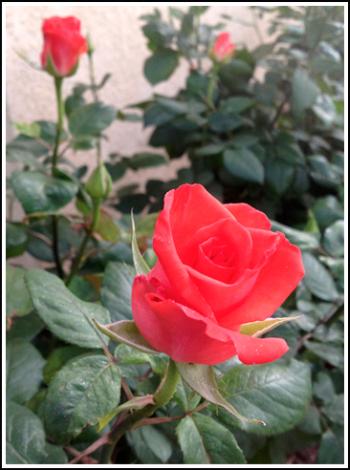Things to notice:
You may notice prickly pear cactus pads lying on the ground with a withered appearance during winter months. This shriveling is actually a clever adaptation of the lant; by lowering the water content of the pads in winter, the cactus is less likely to suffer damage from freezing. The pads promptly plump back up in spring!
You may also find your prickly pear and/or cholla cactus covered with a white cottony substance—this is cochineal, a scale insect that lives as a parasite off of these cactus species. Cochineal can easily be removed by hand. Once it’s off the plant, you can squish it to reveal the brilliant scarlet color that has made it so popular in the use of dyes. Cochineal dye was used by the Aztec and Maya, and is still used in products today.
Be on the lookout for visiting bird species. Our Southwest climate is the place of choice for many migrating birds.

Coral Roses, Rosa sp.
“My green thumb came only as a result of the mistakes I made while learning to see things from the plant’s point of view.” –H. Fred Dale
Things to do:
Lemons are swelling and oranges are sweetening on the trees in many Southwestern gardens at this time of year. Their timing is perfect to help combat the winter cold and flu season with heavy doses of vitamin C! Be sure to taste your citrus before harvesting to make sure they are at their peak—citrus fruits will not continue to ripen once they’re picked.
Now is the time to prune your dormant plants in low desert regions, as temperatures are above freezing and danger of frost is past. Tackle your roses and grapes now.
Roses are arriving at nurseries. Choose your favorite varieties and plant them for spring blooms.
Don’t forget to keep your bird feeders filled. Remember that birds need water as much as food!

